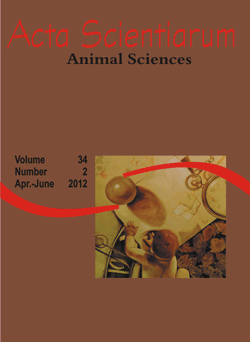<b>Effect of feed restriction with voluntary hay intake on the performance and quality of laying hen eggs</b> - doi: 10.4025/actascianimsci.v34i2.12451
Resumo
The objective was to evaluate the effect of a quantitative feed restriction on the voluntary intake of hay, the performance of laying hens, and on egg quality. A total of 150 Hisex Brown laying hens at 51-weeks old were distributed into five treatments and five replications of six hens each. The treatments consisted of control, with supply of 100 g of feed bird-1 day-1 without hay; and the others consisting of a feed restriction of 5, 10, 15 and 20% of the diet offered to the birds in the control treatment, along with an ad libitum supply of cunhã hay (CH), leucaena leaf meal (LLM) and tifton hay (TH). A linear increase was found in the hay intake with increasing level of dietary restriction. However, egg production, egg weight, egg mass and feed conversion decreased linearly. Yolk color was affected by the treatments. Birds with 20% feed restriction presented the greatest yolk pigmentation. In conclusion, laying hens can be subjected to a 5% feed restriction with supply of hay ad libitum.
Downloads
DECLARAÇÃO DE ORIGINALIDADE E DIREITOS AUTORAIS
Declaro que o presente artigo é original, não tendo sido submetido à publicação em qualquer outro periódico nacional ou internacional, quer seja em parte ou em sua totalidade.
Os direitos autorais pertencem exclusivamente aos autores. Os direitos de licenciamento utilizados pelo periódico é a licença Creative Commons Attribution 4.0 (CC BY 4.0): são permitidos o compartilhamento (cópia e distribuição do material em qualqer meio ou formato) e adaptação (remix, transformação e criação de material a partir do conteúdo assim licenciado para quaisquer fins, inclusive comerciais.
Recomenda-se a leitura desse link para maiores informações sobre o tema: fornecimento de créditos e referências de forma correta, entre outros detalhes cruciais para uso adequado do material licenciado.








































